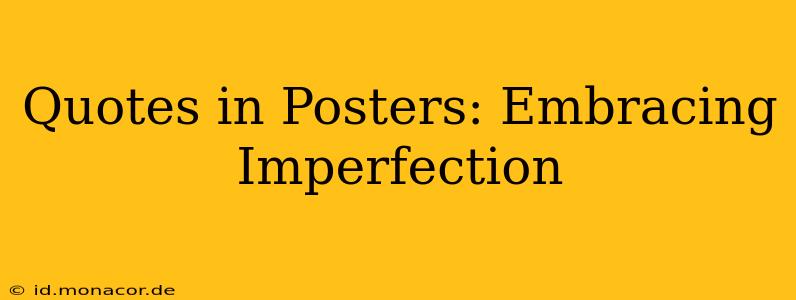Posters, those vibrant squares of visual communication, often leverage the power of words to enhance their message. A carefully chosen quote can transform a simple design into a powerful statement, resonating deeply with the viewer. But what happens when the quote itself embodies the concept of imperfection? This exploration delves into the surprising effectiveness of using imperfect, or seemingly imperfect, quotes in poster design, focusing on how they can foster connection, authenticity, and a more human experience.
Why Use Quotes in Posters at All?
Before diving into the specifics of imperfect quotes, let's establish the fundamental value of incorporating quotes into poster design. Quotes offer a concise and impactful way to convey complex ideas, emotions, or calls to action. A well-chosen quote can:
- Enhance Visual Appeal: A striking quote adds another layer of visual interest, breaking up large blocks of imagery or text.
- Strengthen the Message: Quotes provide context and reinforce the overall theme of the poster. They can add depth and meaning that a visual alone might lack.
- Boost Emotional Engagement: Powerful quotes can evoke strong emotions, making the poster more memorable and impactful.
- Increase Shareability: A memorable quote can encourage social media sharing and wider dissemination of the poster's message.
The Power of Imperfect Quotes in Poster Design
While perfectly polished, grammatically flawless quotes have their place, imperfect quotes—those with a raw, honest, or slightly flawed quality—offer a unique advantage. They resonate more authentically with audiences who are increasingly weary of overly polished perfection.
What constitutes an "imperfect" quote? This could encompass several aspects:
- Handwritten Quotes: The imperfections inherent in handwriting—slight variations in letterforms, unique character, and perhaps even a smudge or two—inject a personal touch that feels relatable and genuine.
- Quotes with Conversational Language: Instead of formal, literary quotes, consider using excerpts of everyday speech, slang, or even slightly grammatically incorrect phrases (if appropriate to the context). This creates a more approachable and down-to-earth feel.
- Quotes that Embrace Vulnerability: Quotes that acknowledge flaws, struggles, or imperfections can foster a sense of connection and understanding with the audience. These quotes offer comfort and validation, demonstrating that it's okay to be imperfect.
- Fragments of Quotes: Using just a portion of a longer quote can create intrigue and encourage reflection. It allows the viewer to fill in the blanks, making the message more personal and engaging.
How to Choose Imperfect Quotes for Your Posters
Selecting the right imperfect quote requires careful consideration. Here's a step-by-step guide:
- Define Your Message: What feeling or message do you want your poster to convey?
- Brainstorm Quotes: Gather potential quotes reflecting your message, considering both well-known and lesser-known sources.
- Consider the Tone: Ensure the chosen quote’s tone aligns perfectly with your poster’s overall aesthetic and message.
- Visualize the Placement: Imagine how the quote will look within the poster’s design. Consider font choice and layout for optimal impact.
- Test and Refine: Before finalizing, test different quote options and layouts to ensure the best possible impact.
Frequently Asked Questions (FAQ)
What fonts work best with imperfect quotes in poster design?
Fonts with a hand-drawn, textured, or slightly irregular feel generally work well with imperfect quotes. Think scripts, brush scripts, or fonts with a vintage or grunge aesthetic. However, the best font choice will depend on the specific quote and the overall style of your poster.
Should I use a single quote or multiple quotes in my poster?
The number of quotes you use depends on the overall design and the length of the quotes themselves. A single powerful quote can be highly effective, while several shorter quotes might be used to build a narrative or create a more layered effect.
How can I ensure the imperfect quality of the quote enhances the message, rather than detracts from it?
The key is balance. The imperfection shouldn't be so significant that it hinders readability or understanding. It should complement the message, lending authenticity and a human touch. If in doubt, test different levels of "imperfection" to find the right balance.
Where can I find imperfect or unusual quotes for my posters?
You can explore various sources, such as literature (poetry, essays), interviews, blogs, and social media. Pay attention to the nuances of language and tone. Consider quotes from lesser-known authors or individuals for a unique perspective.
By embracing the power of imperfection in your poster quotes, you can create designs that are not only visually striking but also deeply resonant and emotionally engaging. This approach fosters authenticity and a genuine connection with your audience, making your posters memorable and impactful.

